In preparation for the exhibition at the London Photo Show they asked if I could provide a brief statement about myself as an artist to include on the website for the show and to put next to the work being displayed. I decided to create the statement for the show in two parts a brief summary about the exhibit and a second slightly longer statement about myself as an Artist. To make sure I covered all of the key information in such a statement I did some research to look for guidelines on producing artist statements. I found two sources (Williams, 2015) ‘How to Write About Contemporary Art’ chapter 4 is dedicated to writing Artist Statements and Agora Advice Blog (Experts et al., 2017) Based on the advice from these two reference sources plus an a discussion about my practice with a fellow student Philip Singleton we crafted an initial version that I refined further to create the final version below.
The statement provides the reader with insight into my motivation for photography and the type of work I produce and its purpose. Overall I am happy with the current version though it is something I intend to revisit periodically as my practice continues to develop.
Final version
Last person to leave turn off the tap
‘Last person to leave turn of the tap’ is Simon’s latest body of work that explores Sandford Mill a Water Treatment Plant built in the 1950s and decommissioned in the 1980s. It was built to address water shortages in a rapidly expanding Chelmsford. The building is now in limbo waiting for a decision on its future. The images capture the limbo state of the apparatus used to treat water in the main Filter House.
Simon Fremont – The Explorer’s Eye
Simon has amassed an extraordinary body of work over the years that is unique in the breath and depth of subjects explored. He takes a global perspective in his appreciation of photography yet undoubtedly his home county of Essex, UK, acts as the fulcrum and repeatedly appears in his image making. Having worked for a period in the Netherlands which he attributes to his rediscovery of photography as a creative outlet for his stories, he returned to the county of his birth. He displays a warm affinity for Essex through an ongoing body of work which explores the coastline; its diverse edge condition, both the hardness of the docks and soft, organic erosion that exposes new earthly forms.
Simon is comfortable with this paradox of place and his work has developed a rhythm of the waves that are cyclical yet never repeated. He will adopt traditional techniques yet experiment to create new possibilities that advance the methodology that remains at the core of practice.
He journeys and he dwells. His work is worthy of the gaze that can divine the meaning and complexity that is infused into his images.
Simon is inquisitive to his very core. He takes joy in exploration and this leads to an uncovering of history, place and people. His work is expressed through an engaging narrative that invites the reader to join him on his journey into, through and around his subjects. His perambulations and the pleasantly muted colour palette show a conscious visual control of the multiplicity of his subjects.
He is undertaking the challenging masters programme at Falmouth University’s Institute of Photography and has successfully completed year one.
References
- Experts, A et al., (2017). How To Write An Artist Statement: Tips From The Art Experts – Agora Advice Blog. [online] Agora Advice Blog. Available at: https://www.agora-gallery.com/advice/blog/2016/07/23/how-to-write-artist-statement/ [Accessed 7 Oct. 2017].
- Williams, G. (2015). How to write about contemporary art. London [u.a.]: Thames et Hudson.



Pingback: You are a business – Reflection
Pingback: You are a business - Reflection - Simon Fremont